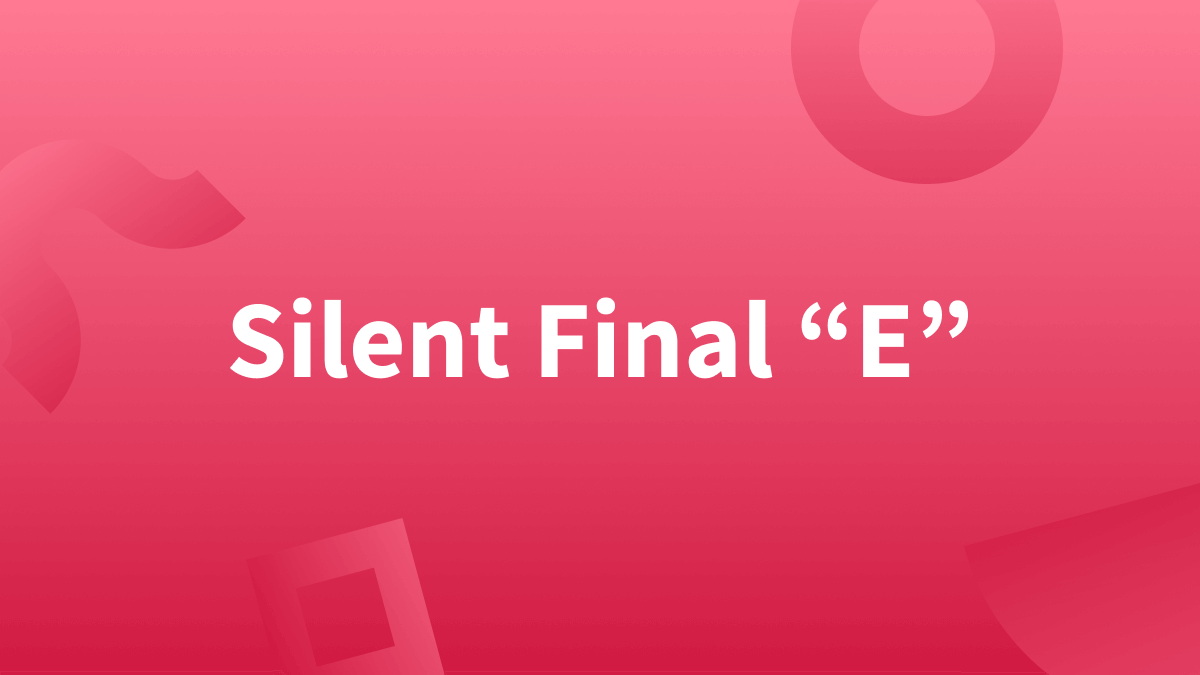Silent E
- A silent “e” at the end of a word can change the pronunciation and meaning of a word (e.g., hop vs. hope).
- But it also changes the pronunciations in words in which omitting the “e” isn’t possible (e.g., strike or bike).
- Not only can silent “e’s” change the pronunciation of preceding vowels, but of consonants as well.
- Silent “e’s” also help prevent words from ending in a “u” or “v,” and help avoid confusion with plural nouns and third-personal singular verbs (e.g., base, promise).
We recently introduced a series of articles that dives into what silent letters are and why they exist. Among other things, we explained that both consonants and vowels could be silent letters. Silent consonants, however, are a lot less predictable and much more baffling. So, in this article, we’ll focus on the silent “e” at the end of words.
Final Silent E—What Does It Do?
The silent “e” at the end of words can play a few important roles. Most prominently, it changes the way a word is pronounced and its meaning. The silent “e” shows that the vowel before the final consonant becomes a long vowel (one that is pronounced like the letter itself). Here are a few examples:
Rid /rɪd/ – to make someone or something free of (a troublesome or unwanted person or thing), relieve
Ride /raɪd/ – be carried or supported by something
Them /ðɛm/ – objective case of “they”
Theme /θiːm/ – a subject or topic of discourse or of artistic representation, a specific and distinct quality, characteristic, or concern
It’s important to note that the final silent “e” also affects the pronunciation of words in which omitting the “e” would make it meaningless.
Rope /roʊp/
Mule /mjuːl/
Scene /siːn/
If this weren’t confusing enough, some words have the same spelling but different pronunciations and meanings. In these cases, the silent “e” applies to one of the words and not the other.
advocate /ˈædvəkət/ (noun) – a person who publicly supports or recommends a particular cause or policy.
advocate /ˈædvəˌkeɪt/ (verb) – publicly recommend or support
minute /ˈmɪnət/ (noun) – a period of time equal to sixty seconds or a sixtieth of an hour
minute /maɪˈnut/ (adjective): extremely small

The “e” at the end of words doesn’t just change the pronunciation of vowels. It can also change the pronunciation of consonants—particularly “c,” “g,” and the consonant digraph “th” (a combination of consonants that represent one sound).
A silent “e” after a “g” or “c” gives the consonants their soft pronunciations, like the “c” in ice or the “g” in age (compared to their hard pronunciation, like the “c” in car, or the “g” in gum).
Most words that end in “th” have an unvoiced consonant sound /θ/, meaning the “th” is pronounced without vibrating the vocal cords (e.g., bath, cloth, teeth). Adding an “e” after a “th,” however, can change it to a voiced pronunciation /ð/ and the meaning of the word (e.g., bathe, clothe, teethe).
Here are a few more examples of words that end with a final silent “e.”
Other Roles of the Silent E
There are a few other reasons why the “silent e” exists. For instance, words in the English language don’t typically end with a “u” or “v.” Sometimes, a silent “e” is added to help maintain this standard (clue, ensue, brave, crave). Additionally, the final “e” in words that end with a single vowel + “ve” may or may not change the pronunciation of the previous vowel—think shave /ʃeɪv/ vs. have /hæv/.
Bonus Tip
Whether you’re a native speaker or an English language learner, it can be challenging to remember which version of a word requires the final silent “e” and which doesn’t. That’s why it’s important to have a handy writing assistant like LanguageTool that will correct common spelling and grammar mistakes and enhance your writing by suggesting stylistic improvements.
The silent “e” at the end of words also helps prevent a singular noun from ending in “s” (course, goose, purse) to avoid it from being confused with a plural noun or third-person singular verb.
Exceptions to the Final Silent E
Staying true to (the English language) form, the rules of the final silent “e” has some exceptions. For example, not every vowel preceding a silent “e” is long (above, give, love).
Also, keep in mind that there are a few words in which the final “e” isn’t silent at all. Here are a few examples:
apostrophe /əˈpɑstrəfi/
recipe /ˈrɛsəpi/
simile /ˈsɪməli/
The English language is complex. And even though the final silent “e” has a bit more logic compared to silent consonants, it can still be difficult to fully understand. Silent “e’s” change the pronunciation and meaning of a word most of the time, but not always. Occasionally, they make the preceding vowel a long one, but not all the time. And other times, the final “e” isn’t even silent. The entirety of the English language is complex, and final silent “e’s” are no different. This article is a simplified explanation of these tricky letters, written so that anyone could understand, regardless of where they are on their English language journey.

